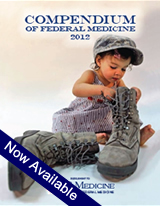Late Breaking News
2012 Compendium
Virtual Reality Is No Game for PTSD Patients Reliving Traumatic Events Cont
- Categorized in: Department of Defense (DoD), Department of Veterans Affairs (VA), May 2012, PTSD, TBI
Then comes the trauma. In the city scene, the ordinary sounds of buyers and sellers and calls to prayer are suddenly replaced by a car-bomb explosion and screams. People run down the street; victims moan and bleed on the road, some clutching stomach wounds, others seemingly unaware they’ve lost limbs. Despite being warned of an impending IED detonation in the Humvee, the jolt, the burst of light and the vehicle filling with smoke creates a powerful experience — even when not processing a personal traumatic memory. Those that are, however, find that the “game” setting becomes very real.
“At this point, we start to talk about what happened, who was hit, who got out of the vehicle. They’re telling me what’s going through their mind, what they’re feeling. In other words, the things that they weren’t able to talk about or even pay attention to at the time — my heart’s racing, my palm’s sweating, the knot in the pit of my stomach,” Gerardi said.
“Perhaps they’re thinking ‘Is there going to be a secondary? Am I going to make it out of here? What about my family?’ If there’s gunfire after the explosion, we include that. Maybe they’re calling for air support, so they hear the A10s overhead and the medevac finally coming in,” she said. In all scenarios, patients continue the memory until they get to a safe place — back on base, for instance.
“The major factor with exposure therapy is the repeated telling of the event. Each time you tell it, you find out it’s OK and you’re safe. Habituation to the fear starts to happen.” To extinguish the fear, Gerardi and her colleagues take research participants through the specific memory three or four times in a session. “Then we do the processing. What were the feelings that came up? What feelings are they struggling with? We talk those through, so they can see the memory from different perspectives and put it in context,” Gerardi added.
Six Sessions
In all, VRE participants have six sessions. In the first, therapists discuss the symptoms of PTSD and how the disorder can impact their lives and relationships and discuss the primary traumatic memory that they will work on in subsequent sessions. In this session, they also assess patient reactivity using the Clinician-Administered PTSD Scale (CAPS) and physiological indicators. The other five sessions focus on the VRE and processing. Patients are reassessed following the conclusion of treatment. Traditional prolonged exposure therapy may take nine to 12 sessions.
“People come into this treatment who would never do traditional talk therapy. Younger guys, in particular, are very comfortable with this. It may be a more acceptable way to confront things. It’s all about developing options to reach more people,” added Gerardi.
Emory’s research is funded by a grant from the National Institute for Mental Health and is designed to include 150 participants. Already at 130, that study will conclude shortly and be replaced by another that was funded by an $11 million DoD grant.
The new multicenter study will build on earlier work indicating the drug D-Cycloserine (DCS) enhances exposure therapy for PTSD. The antibiotic DCS originally was approved to treat tuberculosis, but research has shown that it effectively enhances cognitive behavioral therapy for other anxiety disorders and halves the time needed to extinguish fear in rats. The other study centers are New York-Presbyterian/Cornell Weill in New York, Long Beach VA in California, Walter Reed Army Medical Center Bethesda campus and the National Intrepid Center of Excellence in Washington.
“We are really excited about these studies, because everyone who participates receives active exposure therapy,” said Barbara Rothbaum, PhD, director of the Trauma and Anxiety Recovery Program at Emory University School of Medicine. The goal of the trial is to decrease the time of effective treatment for PTSD and find what works best and for whom. The study also will look at genetic variants that affect development of PTSD and the extinction of fear, which will “move us toward more personalization of treatment,” Rothbaum said.
Researchers will enroll 300 participants. Each participant will receive two educational sessions, followed by seven weekly sessions of either virtual reality exposure therapy or prolonged imaginal exposure therapy. Participants will also be randomly assigned to receive a pill containing either DCS or placebo prior to their therapy sessions.
Email to Friend
Fill in the form below to send this psychiatry to a friend:
Related Psychiatry Articles
- Front-Line Clinicians Get Practical Advice To Help Combat Military Suicides
- Potential Overuse of Antipsychotic Drugs for PTSD Patients is Under Review
- Army: Forensic Psychiatry No Longer Used for PTSD Disability Evaluations
- What Is the Role of Immune Dysfunction in Schizophrenia? VA Researchers Seek to Find Out
- Social Skills Training for Veterans with Schizophrenia Changes Lives for Better
- Convenient Primary Care Reduces CV Risk Factors in Mentally Ill
- With One Suicide on Average Each Day, DoD, VA Leaders Struggle for Better Solutions
- Sergeant Major of the Army Recounts How He Overcame PTSD: IoM Report Calls for Annual Screening by DoD
- Checklist of Environmental Hazards Helps Reduce Inpatient Suicides in VAMCs
- Promising Therapies Available for Sleep Disorders Frequently Related to PTSD and TBI



